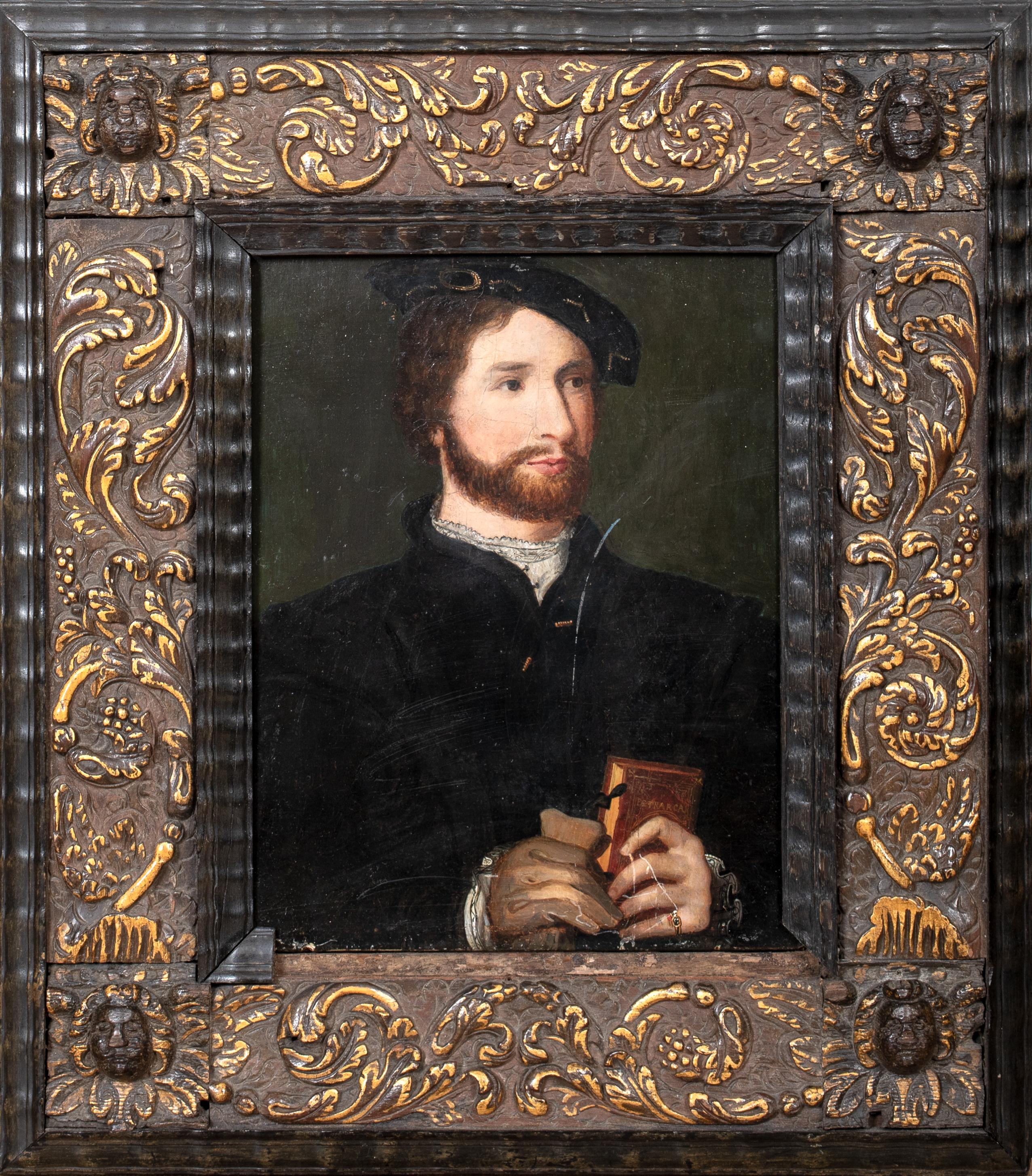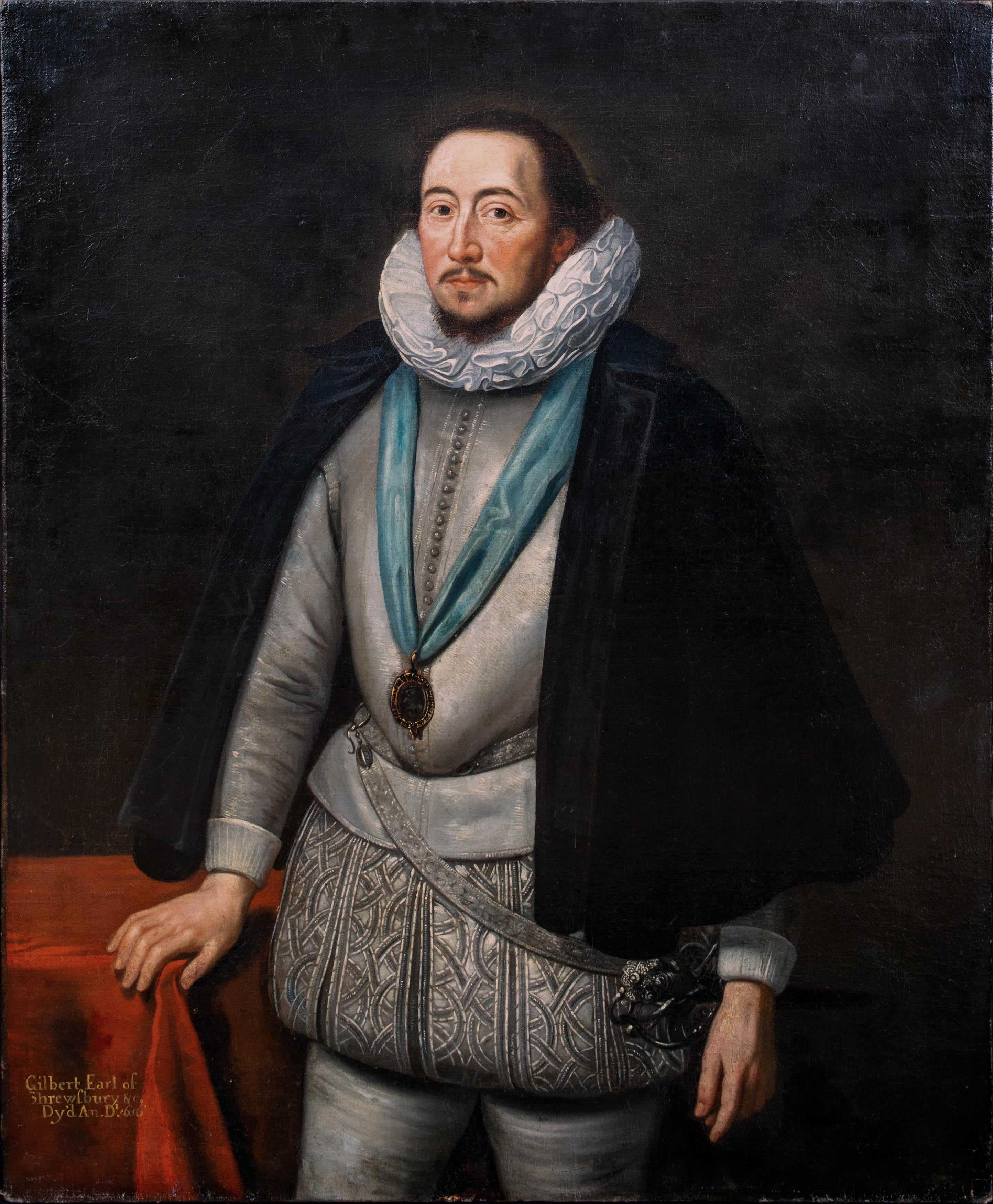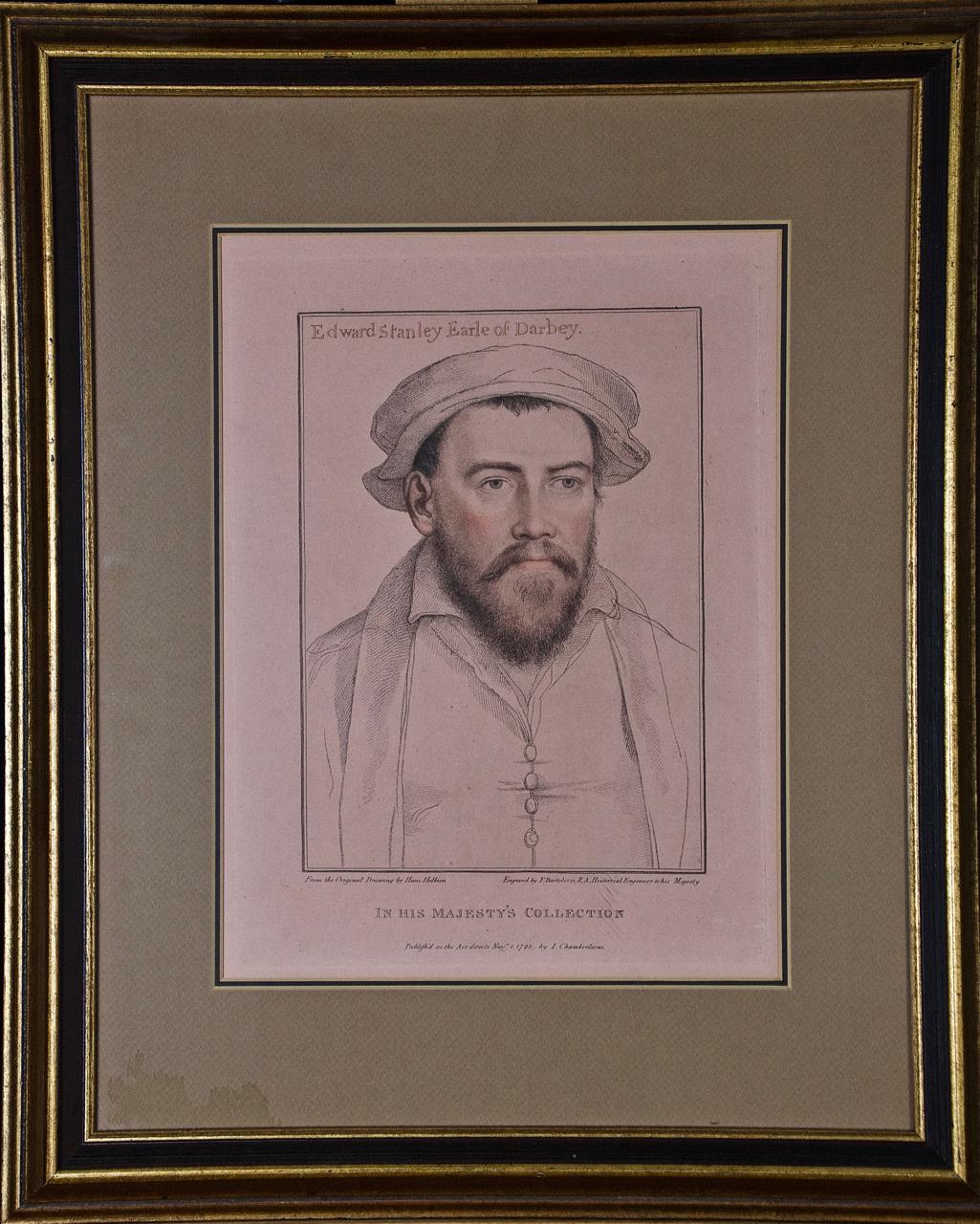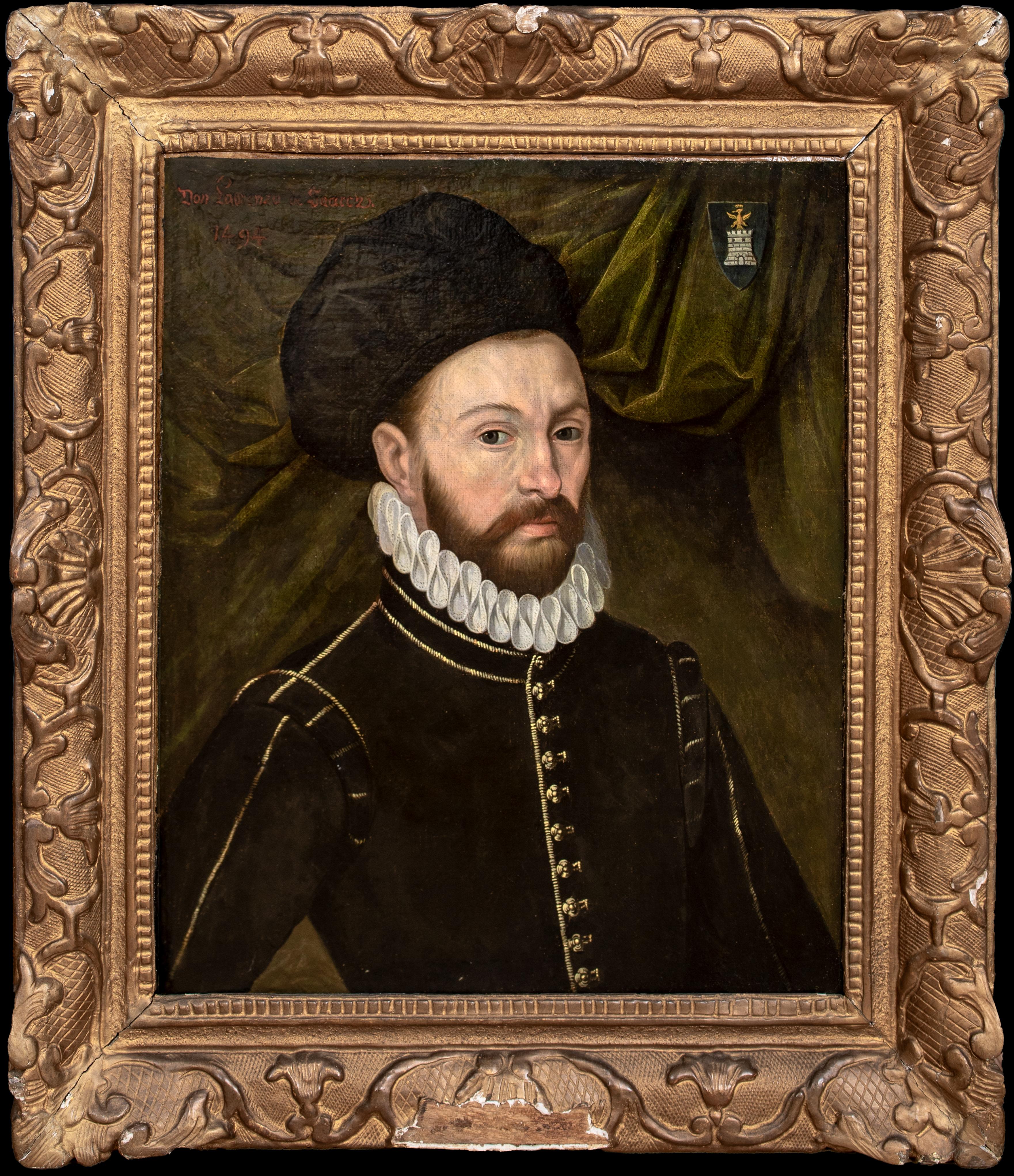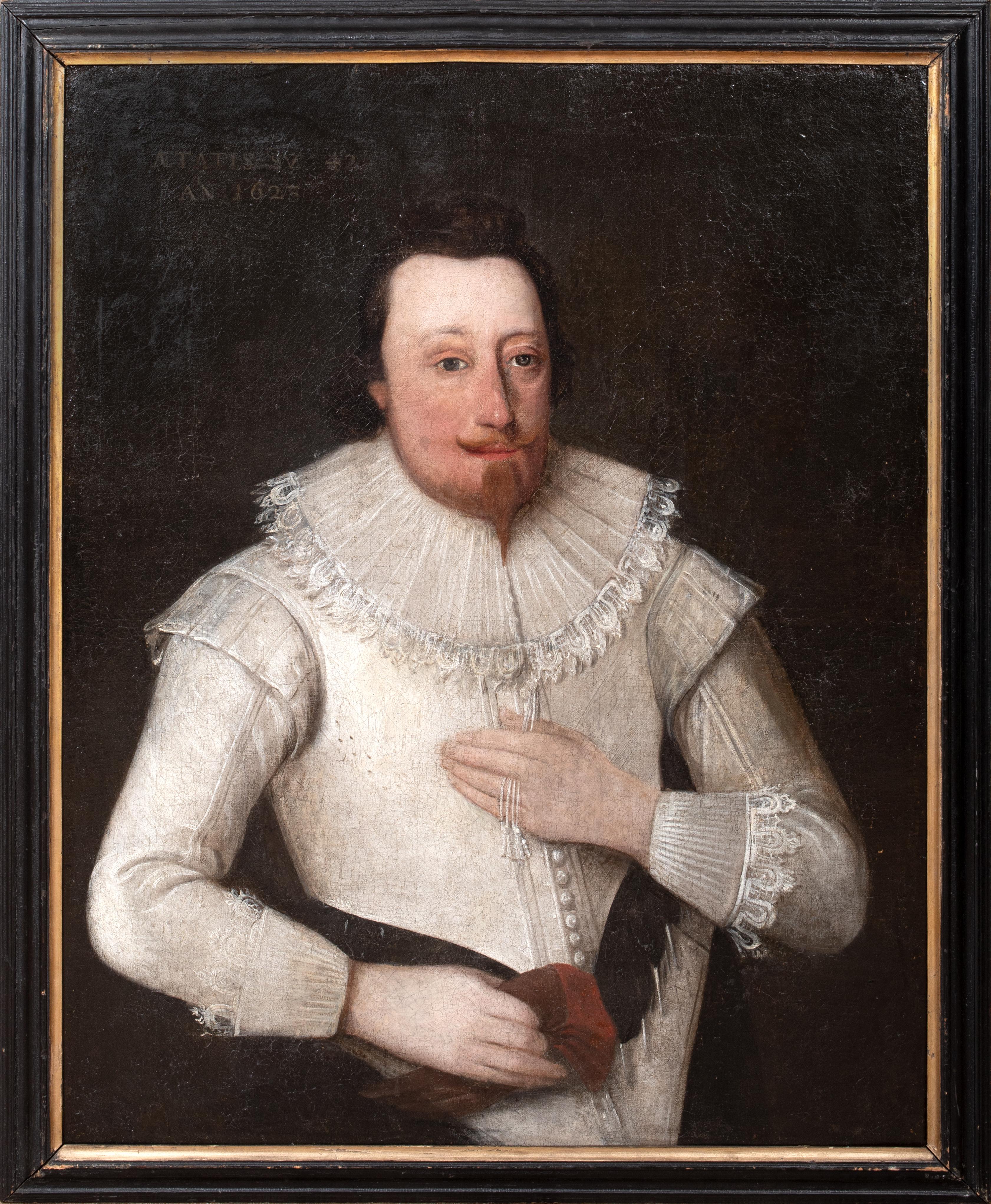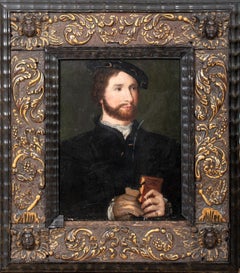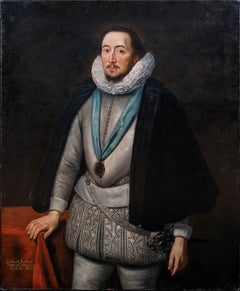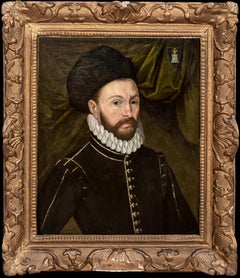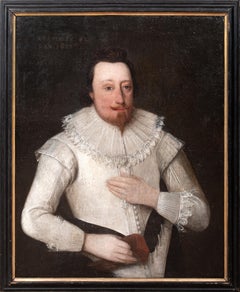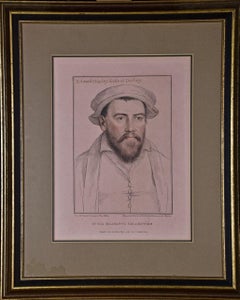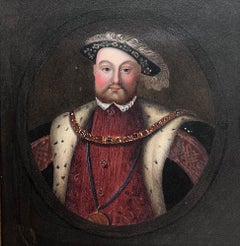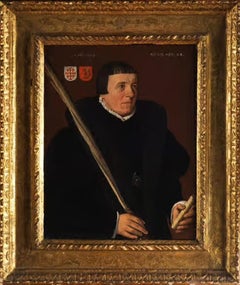Items Similar to Portrait Of Thomas Smythe (1514-1577) School of Hans HOLBEIN (1497-1543)
Want more images or videos?
Request additional images or videos from the seller
1 of 5
Portrait Of Thomas Smythe (1514-1577) School of Hans HOLBEIN (1497-1543)1570
1570
$22,069.89
$27,587.3620% Off
£16,000
£20,00020% Off
€18,849.76
€23,562.2020% Off
CA$30,315.14
CA$37,893.9220% Off
A$33,708.69
A$42,135.8620% Off
CHF 17,647.11
CHF 22,058.8820% Off
MX$411,757.95
MX$514,697.4420% Off
NOK 221,753.30
NOK 277,191.6220% Off
SEK 208,603.42
SEK 260,754.2720% Off
DKK 140,712.17
DKK 175,890.2120% Off
About the Item
Portrait Of Thomas Smythe (1514-1577), 16th Century
School of Hans HOLBEIN (1497-1543)
Fine huge 16th Century English Old Master portrait of Sir Thomas Smythe, oil on canvas, Magnificent huge scale full length portrait in an interior wearing a fur lined coat, his hand on a globe, holding a glove and bearing the sitters coat of arms. Inscribed and titled on the frame plaque. Exceptional condition for its age and presented in a good wooden frame, Likely to be by a close member of Holbein's circle.
Provenance
Spains Hall, Finchingfield, and thence by descent to the present owner
Another portrait of Sir Thomas Smythe, by Thomas Hudson, is at Queens' College, Cambridge University.
Measurements: 80" x 57" framed
- Creation Year:1570
- Dimensions:Height: 80 in (203.2 cm)Width: 57 in (144.78 cm)
- Medium:
- Movement & Style:
- Circle Of:Hans Holbein (1497 - 1543, German)
- Period:
- Condition:
- Gallery Location:Blackwater, GB
- Reference Number:1stDibs: LU157728220982
About the Seller
4.9
Gold Seller
Premium sellers maintaining a 4.3+ rating and 24-hour response times
Established in 2008
1stDibs seller since 2021
294 sales on 1stDibs
Typical response time: 3 hours
- ShippingRetrieving quote...Shipping from: Blackwater, United Kingdom
- Return Policy
Authenticity Guarantee
In the unlikely event there’s an issue with an item’s authenticity, contact us within 1 year for a full refund. DetailsMoney-Back Guarantee
If your item is not as described, is damaged in transit, or does not arrive, contact us within 7 days for a full refund. Details24-Hour Cancellation
You have a 24-hour grace period in which to reconsider your purchase, with no questions asked.Vetted Professional Sellers
Our world-class sellers must adhere to strict standards for service and quality, maintaining the integrity of our listings.Price-Match Guarantee
If you find that a seller listed the same item for a lower price elsewhere, we’ll match it.Trusted Global Delivery
Our best-in-class carrier network provides specialized shipping options worldwide, including custom delivery.More From This Seller
View AllPortrait Of Henry Howard, Earl of Surrey (1516-1547), 16th Century
Located in Blackwater, GB
Portrait Of Henry Howard, Earl of Surrey (1516-1547), 16th Century
English School Court Portrait
16th century English Court Portrait of Henry Howard, Earl of Surrey, oil on panel. ...
Category
16th Century Portrait Paintings
Materials
Oil, Wood Panel
$5,399 Sale Price
20% Off
Portrait Of Gilbert Talbot 7th Earl of Shrewsbury (1552-1616), 16th Century
Located in Blackwater, GB
Portrait Of Gilbert Talbot 7th Earl of Shrewsbury (1552-1616), 16th Century
Circle of George Gower (c.1540–1596)
Huge 16th Century Portrait Of Gil...
Category
18th Century Portrait Paintings
Materials
Canvas, Oil
$16,529 Sale Price
20% Off
Portrait Of Lorenzo Suarez 5th Count Of Corona 16th Century - Antonis Mor
Located in Blackwater, GB
Portrait Of Lorenzo Suarez, 5th Count Of Corona, 16th/17th Century
School of Antonis Mor (1517-1577)
Large Spanish School Old Master portrait of Lorenzo Suarez, Count of Corona, oi...
Category
16th Century Portrait Paintings
Materials
Oil, Canvas
$12,121 Sale Price
20% Off
Portrait Of A Gentleman, identified as Robert Carr, Earl Of Somerset (1587-1645)
Located in Blackwater, GB
Portrait Of A Gentleman, identified as Robert Carr, Earl Of Somerset (1587-1645), 17th Century
English Court Portrait dated 1625
Large 17th Century English Court Portrait, possibly...
Category
17th Century Portrait Paintings
Materials
Canvas, Oil
$6,611 Sale Price
20% Off
Portrait Of King Henry VIII (1491-1547), 17th Century Royal Court Portrait
Located in Blackwater, GB
Portrait Of King Henry VIII (1491-1547), 17th Century
English School Royal Court Portrait
Large 17th Century English Royal Court Portrait of King Henry VIII Of England, oil on canv...
Category
17th Century Portrait Paintings
Materials
Canvas, Oil
$6,060 Sale Price
20% Off
Portrait of Henry IV, King of England (1367-1413), 16th Century
Located in Blackwater, GB
Portrait of Henry IV, King of England (1367-1413), 16th Century
English School Portrait - Early Oil On Panel
Large 16th Century court portrait of Henry IV, King Of England (1367-14...
Category
16th Century Portrait Paintings
Materials
Oil, Wood Panel
$14,325 Sale Price
20% Off
You May Also Like
18th C. Portrait of Edward Stanley from Henry VIII's Court after Holbein Drawing
By Hans Holbein
Located in Alamo, CA
This is an 18th century engraved portrait of "Edward Stanley" created by Francesco Bartolozzi (1728–1815), after a drawing by Hans Holbein the Younger (1497- 1543) in the 16th century. Holbein was the official artist in the court of King Henry VIII. Bartolozzi used both etching and stipple engraving techniques to create the work which was published by John Chamberlaine in London in 1793 in "The Book of Imitations of Original Drawings by Hans Holbein in the Collection of His Majesty".
Edward Stanley, 3rd Earl of Derby...
Category
Late 18th Century Old Masters Portrait Prints
Materials
Engraving, Etching
Portrait of William Herbert, 3rd Earl of Pembroke, Early 17th Century Portrait
Located in London, GB
English School, (circa 1600)
Portrait of William Herbert, 3rd Earl of Pembroke
Oil on panel, oval
Image size: 29¼ x 23⅞ inches
Painted wooden frame
Provenance:
176, Collection of Francis Greville, 1st Earl of Warwick.
The Trustees of the Lord Brooks’ Settlement, (removed from Warwick Castle).
Sotheby’s, London, 22nd March 1968, lot 81.
Painted onto wooden panel, this portrait shows a dark haired gentleman in profile sporting an open white shirt. On top of this garments is a richly detailed black cloak, decorated with gold thread and lined with a sumptuous crimson lining. With the red silk inside it’s all very expensive and would fall under sumptuary laws – so this is a nobleman of high degree.
It’s melancholic air conforms to the contemporary popularity of this very human condition, evident in fashionable poetry and music of the period. In comparison to our own modern prejudices, melancholy was associated with creativity in this period.
This portrait appeared in the earliest described list of pictures of Warwick castle dating to 1762. Compiled by collector and antiquary Sir William Musgrave ‘taken from the information of Lord & Lady Warwick’ (Add. MSS, 5726 fol. 3) is described;
‘8. Earl of Essex – an original by Zuccharo – seen in profile with black hair. Holding a black robe across his breast with his right hand.’
As tempting as it is to imagine that this is a portrait of Robert Devereux, the 2nd Earl Essex, we might take this with a pinch of salt. Its identification with this romantic and fatal Elizabethan might well have been an attempt to add romance to Warwick Castle’s walls. It doesn’t correspond all that well with Essex’s portraits around 1600 after his return from Cadiz. Notably, this picture was presumably hung not too far away from the castle’s two portraits of Queen Elizabeth I. The first, and undoubtedly the best, being the exquisite coronation portrait that was sold by Lord Brooke in the late 1970s and now hangs in the National Portrait Gallery. The second, described as being ‘a copy from the original at Ld Hydes’, has yet to resurface.
The portrait eventually ended up being hung in the State Bedroom of Warwick Castle.
Archival documents present one other interesting candidate. The Greville family’s earliest inventory of paintings, made in 1630 at their home Brooke House in Holborn, London, describes five portraits of identified figures. All five belonged to the courtier, politician and poet Sir Fulke Greville (1554-1628), 1st Baron Brooke, and were hung in the ‘Gallerie’ of Brooke House behind yellow curtains. One of them was described as being of ‘Lord of Pembrooke’, which is likely to have been William Herbert (1580-1630), 3rd Earl of Pembroke. William was the eldest son of Greville’s best friend’s sister Mary Sidney, and was brought up in the particularly literary and poetically orientated household which his mother had supported. Notably, the 3rd Earl was one of the figures that Shakespeare’s first folio was dedicated to in 1623.
The melancholic air to the portrait corresponds to William’s own pretensions as a learned and poetic figure. The richness of the robe in the painting, sporting golden thread and a spotted black fabric, is indicative of wealth beyond that of a simple poet or actor. The portrait’s dating to around the year 1600 might have coincided with William’s father death and his own rise to the Pembroke Earldom. This period of his life too was imbued with personal sadness, as an illicit affair with a Mary Fitton had resulted in a pregnancy and eventual banishment by Elizabeth I to Wilton after a short spell in Fleet Prison. His illegitimate son died shortly after being born. Despite being a close follower of the Earl of Essex, William had side-stepped supporting Devereux in the fatal uprising against the Queen and eventually regained favour at the court of the next monarch James I.
His linen shirt is edged with a delicate border of lace and his black cloak is lined on the inside with sumptuous scarlet and richly decorated on the outside with gold braid and a pattern of embroidered black spots.
Despite the richness of his clothes, William Herbert has been presented in a dishevelled state of semi-undress, his shirt unlaced far down his chest with the ties lying limply over his hand, indicating that he is in a state of distracted detachment. It has been suggested that the fashion for melancholy was rooted in an increase in self-consciousness and introspective reflection during the late 16th and early 17th centuries.
In contemporary literature melancholy was said to be caused by a plenitude of the melancholy humor, one of the four vital humors, which were thought to regulate the functions of the body. An abundance of the melancholia humor was associated with a heightened creativity and intellectual ability and hence melancholy was linked to the notion of genius, as reflected in the work of the Oxford scholar Robert Burton, who in his work ‘The Anatomy of Melancholy’, described the Malcontent as ‘of all others [the]… most witty, [who] causeth many times divine ravishment, and a kind of enthusiamus… which stirreth them up to be excellent Philosophers, Poets and Prophets.’ (R. Burton, The Anatomy of Melancholy, London, 1621 in R. Strong, ‘Elizabethan Malady: Melancholy in Elizabethan and Jacobean Portraits’, Apollo, LXXIX, 1964).
Melancholy was viewed as a highly fashionable affliction under Elizabeth I, and her successor James I, and a dejected demeanour was adopted by wealthy young men, often presenting themselves as scholars or despondent lovers, as reflected in the portraiture and literature from this period. Although the sitter in this portrait is, as yet, unidentified, it seems probable that he was a nobleman with literary or artistic ambitions, following in the same vain as such famous figures as the aristocratic poet and dramatist, Edward de Vere...
Category
Early 17th Century Old Masters Portrait Paintings
Materials
Oil, Wood Panel
Portrait King Henry 8th VIII Antique English Painting Famous Monarch
Located in Cirencester, Gloucestershire
King Henry VIII
English artist, circa 1840's
oil on paper laid on board, framed
framed: 10.5 x 10inches
board: 8 x 7.5 inches
inscribed verso
provenance: private collection, UK
cond...
Category
Early 19th Century English School Portrait Paintings
Materials
Oil
16th Century Jan van Scorel Portrait of a member of the brotherhood of Jerusalem
By Jan van Scorel
Located in Milano, Lombardia
Jan van Scorel (Schoorl, The Netherlands, 1495 – Utrecht, The Netherlands, 1562)
Title: Portrait of a member of the brotherhood of Jerusalem
Medium: Oil on panel
Dimension: without ...
Category
16th Century Old Masters Portrait Paintings
Materials
Oil, Wood Panel
Portrait Noble Man Ceresa Paint Oil on canvas Old master 17th Century Italy Art
Located in Riva del Garda, IT
Carlo Ceresa (San Giovanni Bianco 1609 - Bergamo 1679) attributable
Full-length portrait of Giacomo Pesenti
Oil on canvas (206 x 121 cm - in frame 212 x 133 cm.)
This fascinating portrait, portraying a full-length gentleman and datable to the 17th century, illustrates the stylistic and compositional details typical of the pictorial production of the Lombardy area, Bergamo in particular. This reference is reflected in elements such as the natural light, the sober and austere setting and, above all, the subtle psychological characterisation of the face.
We are inclined to identify the hand of portrait painter Carlo Ceresa, one of the most illustrious Bergamasque figure painters of the 17th century, capable of developing a style of intense realism and acute psychological investigation. In his works, and our portrait perfectly reflects his canons, an extraordinary naturalistic imprint, great realism and remarkable essentiality are evident.
Those traits of severity, moral rigour and austerity typical of his portraiture find a perfect balance here: never courtly or rhetorical, his portraits are profoundly linked to the concept of counter-reform. Immortalising the main personalities of the time, he established himself as a point of reference for the Bergamasque aristocracy, from the Vertova to the Pesenti to the Secco Suardo.
The subject of the portrait is Giacomo Pesenti, here immortalised life-size in a rigorous black suit, his left hand resting on a table, on which is placed the necessities for writing and a manuscript, and his right hand, with a sealed ring on his little finger, abandoned along his side while he holds his gloves.
He wears a suit of incredible rigour, dressed as befits a man of his high social standing, while the sharp light focuses on his face, with an intensity that seems to be accentuated by the reflection of the white collar, with its sharp profile.
For Ceresa, it is not the richness of the garment that gives value to the person portrayed, it is the need to give feeling and bring out the character of the person, and this he succeeds in marvellously, aided by his ability to capture the essence of the person and return it to us in painting through the face and light used as a strong expressive element.
In fact, the image highlights that 'counter-reformed' composure typical of the portraiture of painters active in this area and era, adhering to a verism...
Category
17th Century Old Masters Paintings
Materials
Oil
$12,204 Sale Price
20% Off
Possible Portrait of William Shakespeare
Located in London, GB
Oil on oak panel
Image size: 17 1/4 x 22 1/4 inches (44 x 56.5 cm)
Period oak frame
This is a portrait of a Tudor gentleman in an open next shirt with one hand raised to his chest. ...
Category
Early 1600s Portrait Paintings
Materials
Oak, Oil
More Ways To Browse
Thomas Hand Painting
Spain Old Masters
Coat Of Arms Painting
Full Length Fur Coat
Thomas Smythe
Philip Naviasky
Pieter Hermansz Verelst
Rene Gagnon
Robert Laughlin Painting
Rolf Armstrong 1930
Ryan Gall
Salpi Mavian
Sir Oswald Birley
Suzanne Hurel Art
Suzanne Hurel
Thomas Kent Pelham
Tracy Stuckey American Progress
Transatlantic Cable
